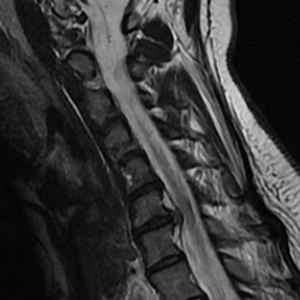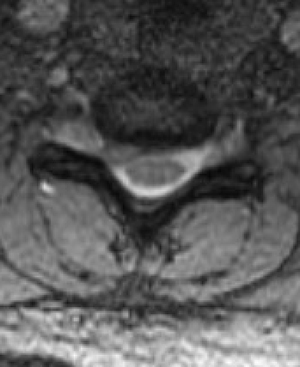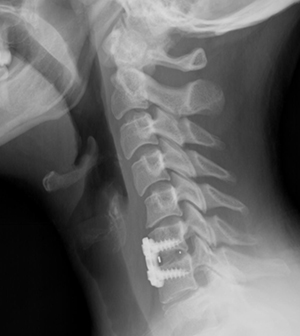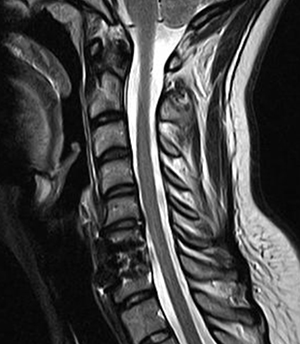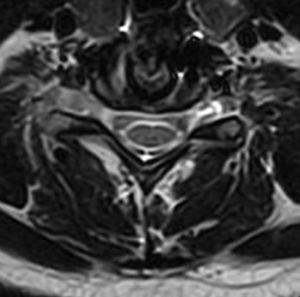Radiculopathy/Myelopathy
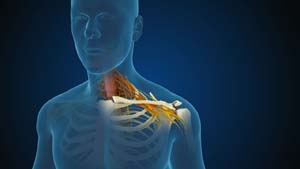
Cervical Spine Anatomy
The spine, also called the backbone, is designed to give us stability, smooth movement, as well as provide a corridor of protection for the delicate spinal cord. It is made up of bony segments called vertebrae and fibrous tissue called intervertebral disks.
What is Cervical Radiculopathy/Myelopathy?
Disk protrusion, also called herniated disk, is a condition caused by a tear in an intervertebral disk, allowing the disk contents to bulge out.
Disk protrusions in the cervical or neck area place pressure on nerve roots (nerve root compression) resulting in radiculopathy or on the spinal cord causing myelopathy. Radiculopathy is a medical term used to describe the neurological deficits that can occur from pressure on the nerves which causes arm or finger weakness, numbness, and pain; this is the equivalent of sciatica in the arms. However, if the compression is of the spinal cord, the result is myelopathy which presents with hand clumsiness, burning pain the hands, and gait difficulty. If the compression becomes severe it can result in paralysis. Fortunately, both cervical radiculopathy and myelopathy can be treated if diagnosed promptly.
Causes of Cervical Radiculopathy/Myelopathy
Conditions that can cause radiculopathy/myelopathy include:
- Degenerative disk disease: Wear and tear of the disks between the vertebrae, causing them to lose their cushioning ability
- Spinal stenosis: Narrowing of the spinal canal as we age, most commonly due to degenerative arthritis
- Degenerative spondylolisthesis: Degeneration (wear and tear) of the vertebral components, usually occurring after age 50, causing slippage of a vertebra onto another, spinal stenosis and narrowing of the spinal canal
- Herniated Disc: Herniation of a disk is an anomalous spine condition characterized by the bulging of the inner contents of the intervertebral disk due to cracks in its outer wall.
Symptoms of Cervical Radiculopathy/Myelopathy
Cervical radiculopathy can result in pain, numbness, or weakness in the shoulder, arm, wrist or hand. Myelopathy presents with weakness, problems manipulating small objects and difficulty with a normal gait.
Diagnosis of Cervical Radiculopathy/Myelopathy
In addition to a complete history and physical examination, your doctor may order spine X-ray, MRI or CT scans, electromyography and nerve conduction studies to diagnose cervical radiculopathy and myelopathy.
Treatment Options for Cervical Radiculopathy/Myelopathy
When conservative treatment measures such as rest, medication, physical therapy, and pain-blocking injections are ineffective, your surgeon may recommend spine surgery.
The most common spine surgery to relieve your symptoms of nerve root compression involves removing the disk and fusing the two vertebrae above and below it with a bone graft. This is accomplished by going through the front of you neck (ACDF). A newer treatment option is now available to replace the herniated disk with an artificial disk. Artificial disks are used in place of a bone fusion to preserve your neck’s movement and flexibility. This artificial disc is also placed by going through the front of your neck. Sometimes however, if many discs are involved, you may need a surgery from the back of you neck where a portion of the bone or lamina is removed. A spinal fusion with screws and rods are then inserted typically to stabilize the spine. A new technique can replace the fusion by not removing the bone but reshaping the bone and preserving mobility to your neck. This procedure is called a laminoplasty.
Case Study
32 year old female comes with right arm pain that radiates all the way down to her fingers. We tried therapy, injections, oral pain medicine, and time. Because of the pain, a MRI showed a herniated disc in her neck on the right side (arrow). The left image is a side view and the right images is a cross section view.
She underwent a minimally invasive anterior cervical discectomy and fusion after removing the herniated disc. A MRI shows resolution of the herniated disc.
- Cervical Corpectomy
- Posterior Cervical Fusion
- Cervical Laminoplasty
- Cervical Disk Replacement
- Cervical Discectomy With Fusion
- Case Study 3
- Case Study 5
- Case Study 8
- Case Study 9

